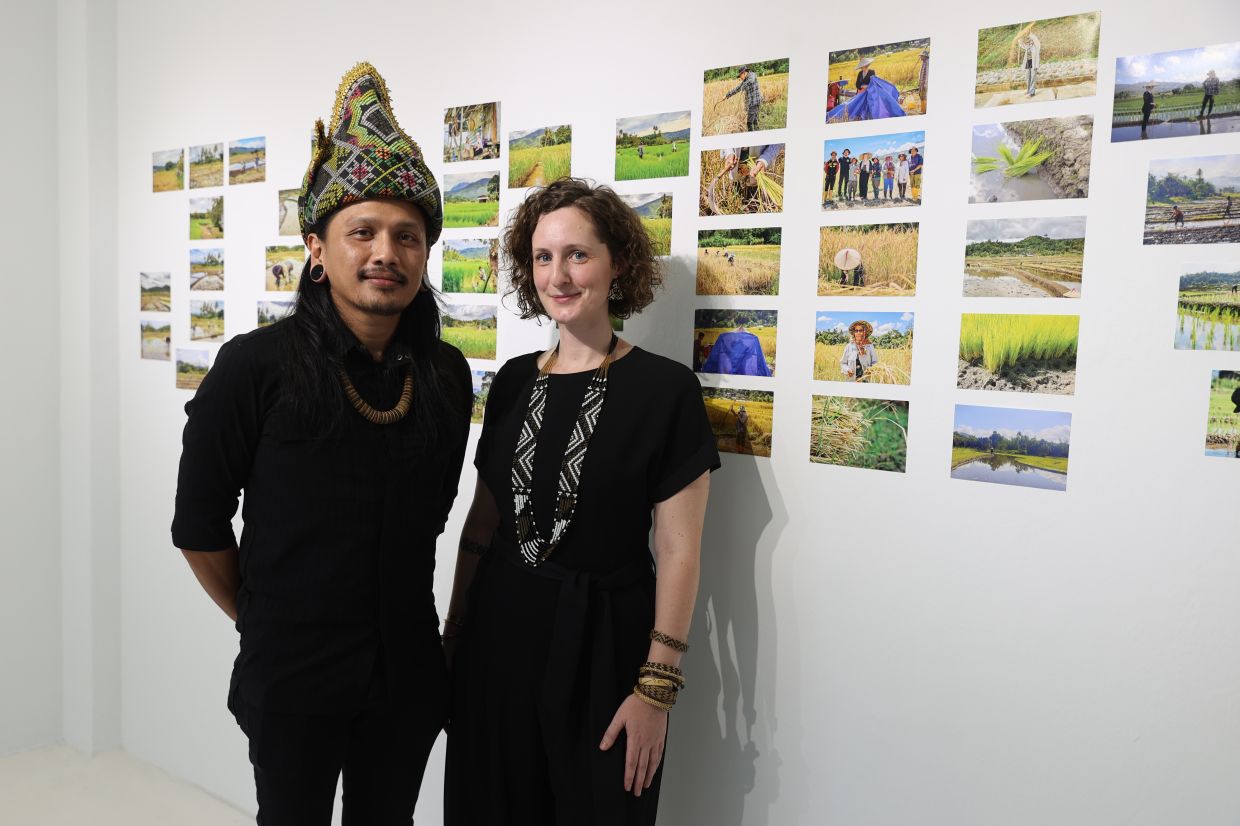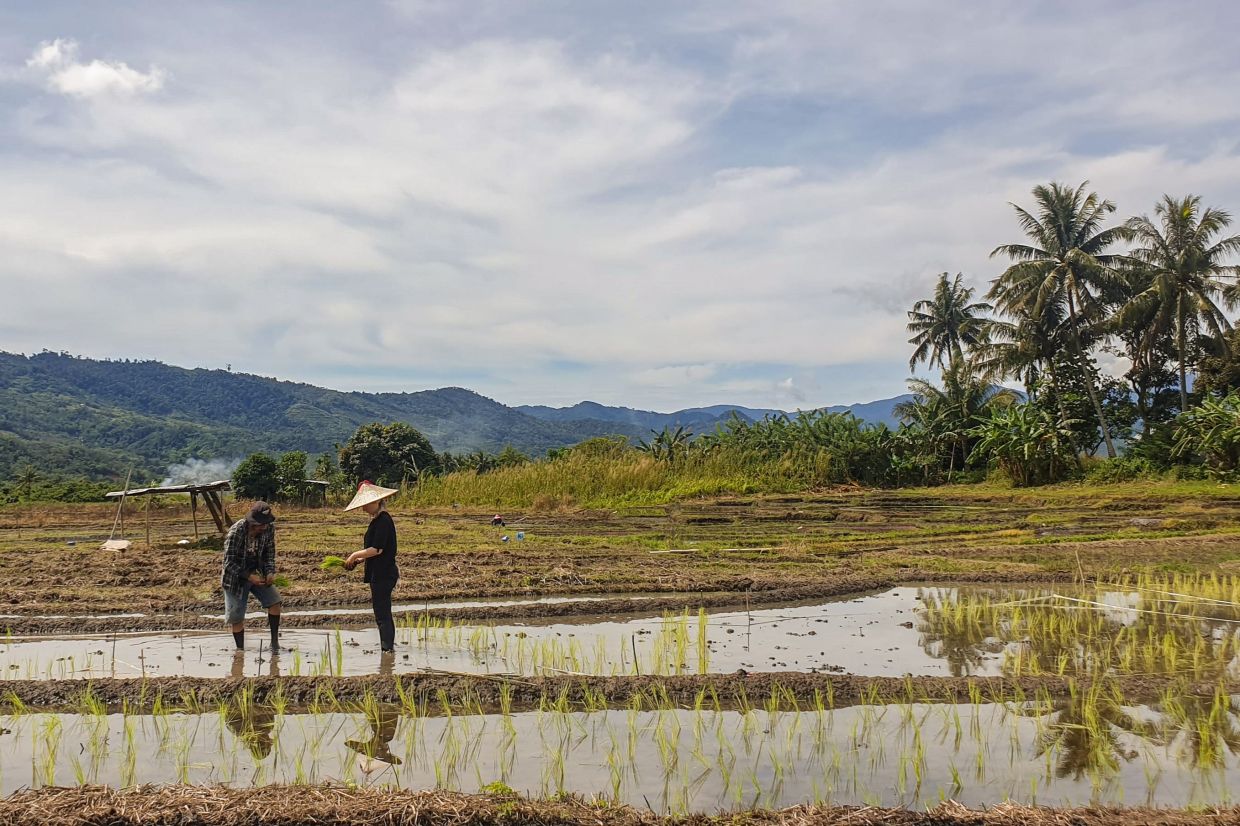Artists Gindung Mc Feddy Simon (left) and Catriona Maddocks (middle) with curator Sonia Luhong Wan pose with the rice grains harvested from the 'Pagar & Padi' project at The Back Room Gallery in Kuala Lumpur. Photo: The Star/ Glenn Guan
"My body will give rise to all sorts of edible plants and feed the people. My flesh will give rise to rice, my head – the coconut, my bones – tapioca, my toes – ginger, my teeth – maize and my knees – yams. Our people will never go hungry again.”
These are among the first words that greet you as you step into the Pagar & Padi exhibition space at The Back Room gallery, Zhongshan building in Kuala Lumpur, written in the language of the Dusun people.
The quote comes from the Dusun legend of Huminodun, whose selfless sacrifice was believed to have brought the paddy crop to the famine-stricken people of Sabah.
Another word of note that you’ll encounter is "JAMIN" (guarantee in Bahasa Malaysia), spelled out on the wall using photographs. This refers to the guarantee made to the people of Sabah when it agreed to join Malaysia in 1963.
The Pagar & Padi exhibition shares the underlying message and process behind the 6m piece of land art in the foothills of Mount Kinabalu by Sabahan artist Gindung Mc Feddy Simon and Sarawak-based British artist Catriona Maddocks, created as a reminder of that guarantee using paddy crops.
An oath to keep
Simon, who is a co-founder of art collective Pangrok Sulap, says that the idea for the project was inspired by the Keningau Oath Stone.
“In 1964, the oath stone was erected to commemorate the formation of Malaysia and the terms by which Sabah agreed to its role in the building of the Malaysian nation. We chose the word ‘jamin’ for the project because the plaque on the oath stone stated that the Malaysian government guaranteed (‘Kerajaan Malaysia jamin’) the people of Sabah the rights to freedom of religion, land autonomy and the practice of customs and traditions,” says Simon.
“Paddy farming remains a significant cultural activity to the rural communities in Sabah, so when we were talking about the ‘jamin’, it was natural to take that cultural practice and present it in an art context,” adds Maddocks.
In October 2022, the duo participated in the annual paddy-planting event, known to the Dusun as "mongomot". Using heirloom rice that has been in Simon’s family for generations, the crops were arranged to spell out the word “JAMIN” in a three-acre plot of land in Ranau owned by Simon.
Six months later, in April 2023, the artists personally harvested the paddy and documented the process through drone photography and videography.
“This project ties together the themes of indigenous identity and its connection to the land, as well as nationhood,” shares Maddocks.
Beyond that, the work also celebrates the role that paddy plays in the daily lives and traditional belief systems of ethnic Sabahans, as well as the practice of community members coming together in the spirit of "gotong-royong" (collective clean-up) to assist one another in the annual harvest.
“Paddy has been cultivated by communities in Borneo for countless generations. To take this significant staple food and utilise it to create an artwork has been really exciting, especially as we had the opportunity to work alongside local community members and learn from them the techniques, songs and taboos that have been passed down from their ancestors,” she adds.
Keeping traditions alive
Pagar & Padi was first exhibited earlier this year at Kota-K Art Gallery, Kota Kinabalu, held during the nationally significant months of August and September, as 2023 marks the 60th year of Malaysia’s formation.
For the Kuala Lumpur exhibition, one half of the exhibition space holds the same installations as the original exhibition – a mountain of paddy grains harvested from the land art, a 13-minute video documenting the harvesting process and an installation featuring seven pieces of ragi, or yeast, on a tray.
According to Simon, the number seven is highly regarded by the Dusun people, featuring prominently in many of its folk tales and beliefs.
“For example, when planting paddy, it is tradition to plant seven stalks of paddy first, and when you harvest, you take seven of the stalks out first,” he says, adding that the number seven has ties to the legend of Huminodun, whose spirit is believed to dwell in the paddy.
The artists, who worked with Simon’s parents and members of the local community in the planting and harvesting of the paddy for the project, learned and adhered to traditional practices.
In the video Jamin, you’ll see them whistling to call the wind to blow the paddy husks away and giving chickens as "sogit" (compensation in Dusun) to those who helped them with the harvest.
Unlike Simon, whose family has traditionally grown paddy, Maddocks didn’t have much experience with harvesting paddy. She tells us that taking part in this project helped her connect with the land.
“It’s really hard work. I’ve got a lot more respect for every single grain of rice on my plate and the labour that goes into it. The communal process of planting and harvesting the paddy and eating the rice together has been an enriching experience,” she says.
They were able to harvest five large bags of rice from the paddy planted for the project, which was then shared among their friends and family, and used for the exhibition.
“I think around the world, people are so removed from food production that we don’t value the food we eat. We’re so used to heavily processed food, so I think it’s important for us to have an understanding of where our food comes from by going back to working the soil and eating food that we grow.”
The land remembers
In the other half of the exhibition, there’s a large circle of dirt and a short video showing the second planting of the land art, which took place early this month.
“This is 25kg of soil from the land we planted on,” says Maddocks, gesturing at the dirt.
She reveals that it was renowned Sabahan contemporary artist and co-founder of Kota-K Art Gallery, Yee I-Lann, who prompted the idea.
“She told us at the original exhibition that actually, the guarantee had not been made to the paddy, but to the land. So we realised that if we wanted to talk about land rights, then we needed to bring the land along with us to Kuala Lumpur.”
Maddocks also shares that one unexpected result of the project was how in documenting the project, they were also able to capture the changes that happened around the area.
“When we returned for the second planting, we were able to see a new road that had been built. The weather was also a lot drier than it should be at this time of year, which affects the paddy crops, so we were also able to capture the effects of climate change and how it impacts the local community.”
So for how long will the project continue? For now, the duo is unsure. “We’d like to continue for as long as we can. As long as the ‘jamin’ exists, we should be planting.”
Pagar & Padi is showing at The Back Room, Zhongshan building in Kuala Lumpur until Nov 26. The gallery is free entry, open Wednesday to Sunday, noon-6pm. More info here.













